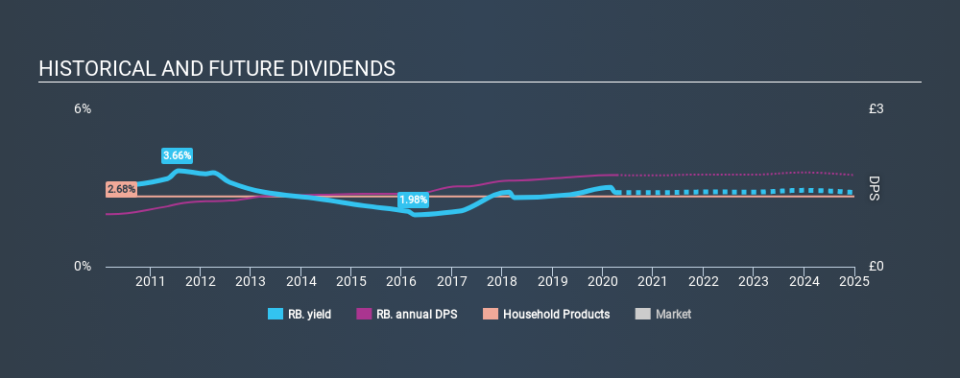Here's Why We're Wary Of Buying Reckitt Benckiser Group plc's (LON:RB.) For Its Upcoming Dividend

Reckitt Benckiser Group plc (LON:RB.) is about to trade ex-dividend in the next 3 days. You will need to purchase shares before the 16th of April to receive the dividend, which will be paid on the 28th of May.
Reckitt Benckiser Group's next dividend payment will be UK£1.02 per share, and in the last 12 months, the company paid a total of UK£1.75 per share. Calculating the last year's worth of payments shows that Reckitt Benckiser Group has a trailing yield of 2.8% on the current share price of £61.68. We love seeing companies pay a dividend, but it's also important to be sure that laying the golden eggs isn't going to kill our golden goose! As a result, readers should always check whether Reckitt Benckiser Group has been able to grow its dividends, or if the dividend might be cut.
View our latest analysis for Reckitt Benckiser Group
Dividends are typically paid out of company income, so if a company pays out more than it earned, its dividend is usually at a higher risk of being cut. Reckitt Benckiser Group lost money last year, so the fact that it's paying a dividend is certainly disconcerting. There might be a good reason for this, but we'd want to look into it further before getting comfortable. Given that the company reported a loss last year, we now need to see if it generated enough free cash flow to fund the dividend. If Reckitt Benckiser Group didn't generate enough cash to pay the dividend, then it must have either paid from cash in the bank or by borrowing money, neither of which is sustainable in the long term. Over the past year it paid out 127% of its free cash flow as dividends, which is uncomfortably high. It's hard to consistently pay out more cash than you generate without either borrowing or using company cash, so we'd wonder how the company justifies this payout level.
Click here to see the company's payout ratio, plus analyst estimates of its future dividends.
Have Earnings And Dividends Been Growing?
Businesses with shrinking earnings are tricky from a dividend perspective. If earnings fall far enough, the company could be forced to cut its dividend. Reckitt Benckiser Group reported a loss last year, and the general trend suggests its earnings have also been declining in recent years, making us wonder if the dividend is at risk.
Another key way to measure a company's dividend prospects is by measuring its historical rate of dividend growth. Since the start of our data, ten years ago, Reckitt Benckiser Group has lifted its dividend by approximately 5.7% a year on average.
Get our latest analysis on Reckitt Benckiser Group's balance sheet health here.
The Bottom Line
Is Reckitt Benckiser Group an attractive dividend stock, or better left on the shelf? First, it's not great to see the company paying a dividend despite being loss-making over the last year. Second, the dividend was not well covered by cash flow." It's not that we think Reckitt Benckiser Group is a bad company, but these characteristics don't generally lead to outstanding dividend performance.
With that in mind though, if the poor dividend characteristics of Reckitt Benckiser Group don't faze you, it's worth being mindful of the risks involved with this business. To that end, you should learn about the 2 warning signs we've spotted with Reckitt Benckiser Group (including 1 which is potentially serious).
We wouldn't recommend just buying the first dividend stock you see, though. Here's a list of interesting dividend stocks with a greater than 2% yield and an upcoming dividend.
If you spot an error that warrants correction, please contact the editor at editorial-team@simplywallst.com. This article by Simply Wall St is general in nature. It does not constitute a recommendation to buy or sell any stock, and does not take account of your objectives, or your financial situation. Simply Wall St has no position in the stocks mentioned.
We aim to bring you long-term focused research analysis driven by fundamental data. Note that our analysis may not factor in the latest price-sensitive company announcements or qualitative material. Thank you for reading.

 Yahoo Finance
Yahoo Finance 
